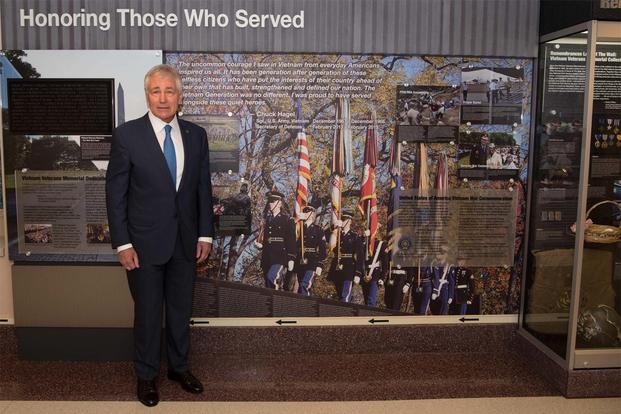The Pentagon this month opened an exhibit on the Vietnam War along a third-floor "A ring" corridor that included the policy mistakes and the bitter lessons learned that Defense Secretary Ashton Carter called "difficult to swallow."
There were examples of the "things they carried" and the weapons that were used, by and against them, as well as a chronological history of the last American war fought by draftees.
Inside a glass display were several of the old flip-open cigarette lighters used by grunts to fire up the four-packs, usually unfiltered Pall Malls, that came with the C-rations. The fading inscription on one of the lighters at the back of the case was difficult to read but on closer inspection stated: "Da Nang, Vietnam -- I believe I'll go into heaven because I've spent my lifetime in hell."
The feeling was common among those in the infantry. There was a standing joke among some junior Marine officers that "mission" was actually the ever-missing second paragraph for Vietnam in what was then the five-paragraph SMEAC order: Situation, Mission, Execution, Administration and Logistics, Command and Control.
What was the fundamental mission of the estimated nine million who served in the Vietnam era, and the more than 58,000 whose names are etched on the black granite walls of the Vietnam War Memorial?
Several presidents had struggled for an answer and Vietnam veteran and former Defense Secretary Chuck Hagel, who joined with Carter at a ribbon-cutting ceremony for the exhibit, was no different.
"It was a difficult time to serve this country," said Hagel, an Army sergeant who received two Purple Hearts during the conflict. It was also a difficult time to come home from the war, Hagel said.
The former Republican senator from Nebraska noted that when he served in Vietnam in 1967 and 1968, there were riots in the street. President Lyndon B. Johnson chose not to run for re-election. The Rev. Martin Luther King Jr., and Sen. Robert F. Kennedy of New York were assassinated.
"There was tremendous social unrest everywhere, and that too was happening in our armed forces," Hagel said. "It was a difficult time inside those armed forces for our officers, our enlisted, and with a real question as to what the clear purpose of the war was.
"Unfortunately, our Vietnam veterans came back to a country that was not only ungrateful, but their service was vilified," Hagel added. "These men and women didn't have anything to do with the policy that put us in Vietnam, but they served this country and they served it as honorably as any generation in the history of this country has served.
"This exhibit very much reflects all that and pays tribute to men and women who never asked for anything in return. They never came back to any expectations -- they wanted to get on with their lives and put that war experience behind them," Hagel said.
The displays included replicas of Huey helicopters and an M-14 rifle, which was replaced by the M-16 during the war. Vietnam vets still argue about the merits of that decision. In another case was an AK-47 Kalashnikov rifle, which was standard issue for the NVA, or North Vietnamese Army, and the VC, or Viet Cong.
There were also displays of some of the devices foisted on the troops by Pentagon bureaucrats that resulted in colossal wastes of time and effort. There was the Seismic Intrusion Detector, or SID, which was intended to pick up enemy movements.
The SIDs were meant to play an integral part in the so-called "McNamara line," named for then-Defense Secretary Robert McNamara, which was to be a system of sensors across the De-Militarized Zone separating North and South Vietnam. The SIDs were useless, and so was the McNamara line.
The chronological history part of the exhibit included fateful policy statements from a series of presidents on U.S. involvement. In 1954, President Dwight D. Eisenhower posed the "falling domino" theory. Abandoning what was then called Indochina would lead to the fall of other countries to communism and pose threats "incalculable to the free world," Eisenhower said.
In 1963, in a statement that has echoes for America's current wars, President John F. Kennedy said of the South Vietnamese forces, "We can help them, we can give them equipment, we can send our men out there as advisers, but they have to win it, the people of Vietnam, against the Communists."
The exhibit was part of the nation's official 50th anniversary commemoration of the Vietnam War that recognizes the 20-year span from Nov. 1, 1955, to May 15, 1975.
Nov. 1, 1955, was chosen to coincide with the official designation of Military Assistance Advisory Group-Vietnam (MAAG-V), and May 15, 1975, marked the seizure of the merchant ship Mayaguez, which was the last official battle of the war.
By presidential proclamation issued May 25, 2012, the official period of the 50th anniversary commemoration extends from Memorial Day 2012 through Veterans Day 2025.
Although the Mayaguez may have been the last official fight, the war never really ended for the returning troops.
Much like today's generation of vets, the Vietnam veterans coming home "needed advocates to help them navigate a convoluted government bureaucracy and claim the benefits that were rightfully theirs," according to a Defense Department statement included in the exhibit.
Nearby was a quote from Col. Albert J. Nahas, a West Point graduate who served in Vietnam in 1968 through 1970: "We heard the call. We answered with our service. We paid the price for others. Let them remember."
-- Richard Sisk can be reached at Richard.Sisk@Military.com.































